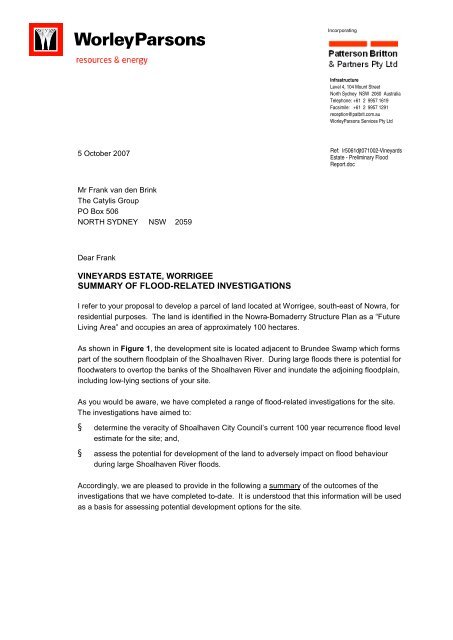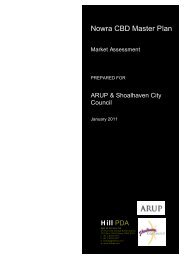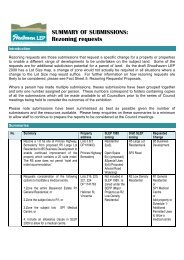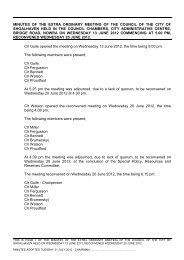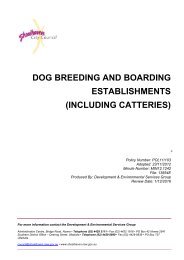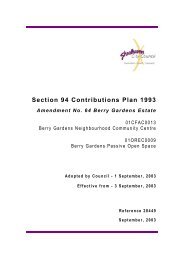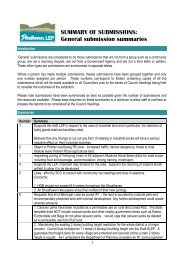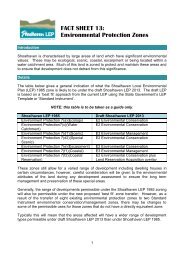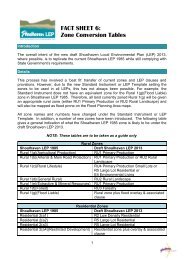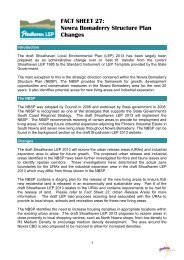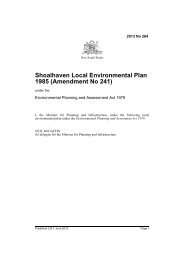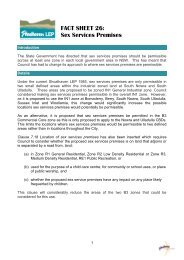Flood Report - Worrigee.pdf - SLEP
Flood Report - Worrigee.pdf - SLEP
Flood Report - Worrigee.pdf - SLEP
You also want an ePaper? Increase the reach of your titles
YUMPU automatically turns print PDFs into web optimized ePapers that Google loves.
IncorporatingInfrastructureLevel 4, 104 Mount StreetNorth Sydney NSW 2060 AustraliaTelephone: +61 2 9957 1619Facsimile: +61 2 9957 1291reception@patbrit.com.auWorleyParsons Services Pty Ltd5 October 2007Ref: lr5061djt071002-VineyardsEstate - Preliminary <strong>Flood</strong><strong>Report</strong>.docMr Frank van den BrinkThe Catylis GroupPO Box 506NORTH SYDNEY NSW 2059Dear FrankVINEYARDS ESTATE, WORRIGEESUMMARY OF FLOOD-RELATED INVESTIGATIONSI refer to your proposal to develop a parcel of land located at <strong>Worrigee</strong>, south-east of Nowra, forresidential purposes. The land is identified in the Nowra-Bomaderry Structure Plan as a “FutureLiving Area” and occupies an area of approximately 100 hectares.As shown in Figure 1, the development site is located adjacent to Brundee Swamp which formspart of the southern floodplain of the Shoalhaven River. During large floods there is potential forfloodwaters to overtop the banks of the Shoalhaven River and inundate the adjoining floodplain,including low-lying sections of your site.As you would be aware, we have completed a range of flood-related investigations for the site.The investigations have aimed to:• determine the veracity of Shoalhaven City Council’s current 100 year recurrence flood levelestimate for the site; and,• assess the potential for development of the land to adversely impact on flood behaviourduring large Shoalhaven River floods.Accordingly, we are pleased to provide in the following a summary of the outcomes of theinvestigations that we have completed to-date. It is understood that this information will be usedas a basis for assessing potential development options for the site.
1. BACKGROUNDDesign flood behaviour along the Lower Shoalhaven River is currently defined using theresults of hydraulic computer modelling that was originally undertaken as part of the ‘LowerShoalhaven River <strong>Flood</strong> Study’ (1990). The hydraulic model of the Shoalhaven River wasdeveloped using the CELLS software, which is a quasi two-dimensional modelling packagethat was originally developed in South Africa in the mid 1970s.The results from the <strong>Flood</strong> Study indicate that the entrance topography at Shoalhaven Headssignificantly influences flood behaviour along the river downstream of Nowra. Accordingly,separate design flood simulations were undertaken for the <strong>Flood</strong> Study using the CELLSmodel assuming that the entrance at Shoalhaven Heads was ‘open’ and ‘closed’. The resultsof the ‘closed’ entrance simulations were adopted by Council for planning purposes as theyprovide the most conservative flood levels estimates within the lower reaches of the river.The results of the CELLS modelling indicate that the current peak 100 year recurrence floodlevel at the development site is 3.48 mAHD. This peak flood level estimate was derivedassuming that the Shoalhaven River entrance is ‘closed’ and that peak inflows from theShoalhaven River catchment occur in conjunction with elevated ocean levels at Shoalhavenand Crookhaven Heads.However, Appendix C of the DNR (now DECC) guideline document titled, ‘<strong>Flood</strong>plain RiskManagement Guideline No 5 – Ocean Boundary Conditions’ (in draft, November 2004)outlines that the initial results of research show that there is little evidence of any correlationbetween catchment floods and elevated ocean water levels. Accordingly, it is considered thatthe current design flood level estimates for the lower Shoalhaven River are overlyconservative. Therefore, we have undertaken additional investigations to develop a morereliable 100 year recurrence flood level estimate for the development site in accordance withGuideline No. 5.2. REVISED 100 YEAR RECURRENCE FLOOD LEVEL FORDEVELOPMENT SITE2.1 Hydrodynamic Model DevelopmentA new, fully two-dimensional hydrodynamic model of the southern floodplain of theShoalhaven River was developed for the project. It was considered that a fully twodimensionalmodel would more reliably simulate flood behaviour in the vicinity of theproposed development. Furthermore, the development itself can be more reliablyrepresented in such a model. The hydrodynamic model was developed using the RMA-2software. The layout of the RMA-2 model is shown in Figure 2.The RMA-2 model was used to simulate the 100 year recurrence flood for both the ‘open’ and‘closed’ Shoalhaven River entrance conditions. The results generated by the RMA-2 modelwere verified against the results generated by the existing CELLS model and were found toreproduce peak 100 year recurrence flood levels at the development site to within 40 mm.This indicates that the RMA-2 model is generating reliable estimates of design floodlr6315_01djt071002-Vineyards Estate - Preliminary <strong>Flood</strong> <strong>Report</strong>.doc 2 5 October 2007
ehaviour in the vicinity of the development site and is suitable for more detailed flood-relatedinvestigations.2.2 Guideline No. 5 – Ocean Boundary ConditionsAs discussed, peak flood levels within the lower reaches of the river system are stronglyinfluenced by the ocean level and entrance conditions at the time of the flood. Accordingly, itis difficult to establish a ‘typical’ design flood due to the various combinations of entrance,ocean level and catchment runoff conditions that could potentially occur in isolation orconcurrently. That is, no two floods are exactly the same and it is difficult to define an‘standard’ design flood.In recognition of the need to provide a consistent approach to defining ocean boundaryconditions for flood modelling in coastal catchments, the DNR (now DECC) developed aguideline document titled, ‘<strong>Flood</strong>plain Risk Management Guideline No 5 – Ocean BoundaryConditions’ (in draft, November 2004). Guideline No 5 provides advice on the derivation ofappropriate ocean boundary conditions for a variety of ocean entrance types.Guideline No. 5 has been applied to a number of coastal catchments throughout NSW. Thisincludes Burrill Lake, which is located within the Shoalhaven City Council Local GovernmentArea.2.3 Hydrodynamic Model ResultsThe verified RMA-2 model was used to simulate a range of design floods in accordance withrecommendations outlined in DECC’s Guideline No. 5 to develop a revised 100 yearrecurrence flood level estimate for the site. This involved developing a ‘design envelope’ byusing the highest peak flood level generated from flood modelling that was undertakenassuming:• a large design flood (e.g., the 100 year recurrence flood) occurs during a normal (neap)tidal cycle; and,• a small design flood (e.g., the 10 year recurrence flood) occurs in conjunction withelevated ocean levels (i.e., 2.6 mAHD).For both design flood simulations it was assumed that the Shoalhaven River entranceremained closed throughout the flood in order to provide a conservative estimate of peakflood levels in the vicinity of the development site. The peak results from both floodsimulations were combined to produce the final 100 year recurrence design envelope for theLower Shoalhaven River.Peak floodwater depths and velocity vectors were extracted from the design flood envelopeand are presented in Figure 3. Figure 3 indicates that the lower-lying sections of the sitewould be inundated at the peak of the 100 year recurrence flood. However, flow velocitiesacross the site are predicted to remain below 0.05 m/s (i.e., very low).lr6315_01djt071002-Vineyards Estate - Preliminary <strong>Flood</strong> <strong>Report</strong>.doc 3 5 October 2007
Predicted peak flood levels in the vicinity of the development site were also extracted from thedesign flood envelope and show that the revised peak 100 year recurrence flood level at thedevelopment site is predicted to be 3.29 mAHD. That is, the adoption of the methodologyoutlined in Guideline No. 5 reduces peak 100 year recurrence flood levels at the developmentsite by approximately 190 mm relative to Shoalhaven City Council’s current design flood levelestimates (as defined by the CELLS model).2.4 Impact of Sea Level RiseGuideline No. 5 notes that no specific allowance for increases in ocean level associated withgreenhouse effects should be incorporated into the derivation of the ‘design envelope’ as theelevated ocean levels specified in the guideline are considered to be conservative.Nevertheless, the guideline does recommend assessing the impact of further increases inpeak ocean levels as part of a sensitivity analysis.Accordingly, additional hydrodynamic model simulations were completed to assess thesensitivity of the predicted 100 year recurrence flood level at the site to increases in oceanlevels.Guideline No. 5 states that median sea levels are predicted to rise by between 0.075 and 0.15metres by 2040. In order to provide a conservative estimate of the impact of sea level rise onthe development site, the flood simulations outlined in Section 2.3 were re-run assuming anincrease in ocean level of 0.2 metres (i.e., 0.05 metres above the predicted upper boundmedian sea level increase value).The results of the design flood simulations were combined to produce a revised design floodenvelope for the 100 year recurrence flood. Based on this, the peak 100 year recurrenceflood level at the development site, incorporating a 0.2 metre allowance for sea levelincreases, is predicted to be 3.31 mAHD. That is, a 0.2 metre increase in peak ocean levelsis predicted to increase peak 100 year recurrence flood levels at the site by just 0.02 metres.This shows that peak 100 year recurrence flood levels at the site are relatively insensitive toincreases in ocean levels.Nevertheless, it is recommended that a peak 100 year recurrence flood level of 3.31 mAHDshould be adopted for the site.3. IMPACT OF FILLING OF THE DEVELOPMENT SITE ON LOCALFLOOD BEHAVIOUR2.1 Indicative Fill PlanAs discussed, lower-lying sections of the development site are predicted to be inundated atthe peak of the 100 year recurrence flood. Accordingly, it will be necessary to undertakeselected filling across the land to maximise the development potential and so that a suitablebuilding platform can be constructed to meet Shoalhaven City Council’s minimum floor levelrequirement. Council’s DCP No. 106 requires that the floor level of any new residentialdevelopment be at least 500 mm above the peak 100 year recurrence flood level.lr6315_01djt071002-Vineyards Estate - Preliminary <strong>Flood</strong> <strong>Report</strong>.doc 4 5 October 2007
A development layout and associated fill plan for the development is yet to be prepared.However, in order to provide a conservative initial assessment of the potential for filling acrossthe site to impact on existing flood behaviour, the indicative fill plan shown in Figure 4 wasadopted. It should be recognised that the fill plan shown in Figure 4 is likely to significantlyover-estimate the extent of filling that will be completed to accommodate future residentialdevelopment across the site. Accordingly, we consider that it will be necessary to completeadditional modelling once a more reliable fill plan is developed for the site.2.2 Impact of Filling on Local <strong>Flood</strong> BehaviourThe hydrodynamic model that was developed to define ‘existing’ flood behaviour in the vicinityof the development site, was updated to reflect the fill proposal shown in Figure 4. Themodified model was then used to re-simulate the design 100 year recurrence flood for ‘postdevelopment’conditions. The magnitude of any changes in flood behaviour arising from theproposed filling was then established by comparing hydrodynamic model results from the‘existing’ and ‘post-development’ scenarios.Peak 100 year recurrence depths and velocity vectors were extracted from the results of the‘post-development’ modelling and are presented in Figure 5. Figure 5 indicates that thefilling will prevent inundation of that section of the site where filling is proposed. However, theflood extent will remain unchanged across the remainder of the floodplain.The predicted peak 100 year recurrence flood level for the post-development scenario wasdetermined to be 3.32 mAHD. That is, the filling shown in Figure 4 is predicted to increasepeak 100 year recurrence flood levels in the vicinity of the site by 10 mm.Flow velocity difference mapping was also developed to assess the impact of the floodplainfilling on peak flow velocities. Difference maps are created by comparing peak flow velocityestimates at each node in the hydrodynamic model network from simulations undertaken forboth ‘existing’ and ‘post-development’ scenarios. This effectively creates a contour map ofpredicted changes in peak flow velocities and allows easy determination of the impact of thefilling on existing flow velocities.Flow velocity difference mapping was developed for the 100 year recurrence flood and ispresented in Figure 6. Increases in peak flow velocity are represented as different shades ofred and decreases in peak flow velocity are represented as shades of blue. The white areasindicate changes in peak flow velocity of less than 0.05 m/s (i.e., negligible changes).Figure 6 shows that the filling is predicted to generate a small, localised increase in peak 100year recurrence flow velocity of 0.06 m/s. This is predicted to occur outside of thedevelopment site, however, does not extend across any existing development.Overall, the filling shown in Figure 4 is predicted to generate small increases in peak floodlevel and flow velocity. However, the magnitude of the increases are not predicted to exposeany existing development to an increase in flood hazard or flood damages relative to existingconditions.lr6315_01djt071002-Vineyards Estate - Preliminary <strong>Flood</strong> <strong>Report</strong>.doc 5 5 October 2007
4. CONCLUSIONSThis report has presented a summary of the outcomes of flood-related investigations thathave been completed for the Vineyards Estate development at <strong>Worrigee</strong>.The following conclusions can be drawn from the results of the investigations:• Shoalhaven City Council’s current 100 year recurrence flood level estimate for thedevelopment site is 3.48 mAHD. This is considered to be overly conservative.• The results of additional hydrodynamic model simulations completed using a fully twodimensionalhydrodynamic model indicate that a more reliable 100 year recurrence floodlevel estimate for the site would be 3.31 mAHD. This incorporates an allowance forincreases in ocean levels associated with climate change.• Although a layout for the proposed development is yet to be developed, a preliminaryassessment of ‘post-development’ flood behaviour indicates that filling of the site willgenerate only small increases in peak 100 year recurrence flood levels and flowvelocities in the vicinity of the development site.Accordingly, it is considered that development of the site, incorporating filling up to the limitshown in Figure 4, could proceed and would not produce any unreasonable impacts onexisting flood behaviour.Nonetheless, we believe that it will be necessary to complete further detailed hydrodynamicinvestigations once a preferred fill plan for the site is developed. Furthermore, the outcomesof the more detailed investigations will need to be documented in a bound <strong>Flood</strong> ImpactAssessment report in a format suitable for submission to Council. We would be happy toproceed with these more detailed investigations once a fill plan for the site has been finalised.---------------------------------We trust that the above report addresses your needs. Please feel free to contact Chris Thomas ormyself should you require any further information.Yours faithfullyWorleyParsonsDavid TetleyProject EngineerWorleyParsonslr6315_01djt071002-Vineyards Estate - Preliminary <strong>Flood</strong> <strong>Report</strong>.doc 6 5 October 2007
.FIGURE 1To WollongongShoalhaven Riverentrance3939Crookhaven RiverentranceTo UlladullaDevelopment siteLEGENDDevelopment siteNOTESAerial photography dated2005Patterson Britton& Partners Pty LtdRp6315-Vineyards Estate FSFig1-Location.docLOCATION OF THE PROPOSEDDEVELOPMENT SITE
.FIGURE 2W12W1139W43W44W45 W47 W62W6839W42W69X6.3W26Development siteLEGENDW25NOTESRMA-2 model finiteelementLocation of RMA-2model inflow andcorresponding CELLSweir numberAerial photography dated2005Patterson Britton& Partners Pty LtdRp6315-Vineyards Estate FSFig-RMA Network.docLAYOUT OF RMA-2MODEL NETWORK
.FIGURE 3Development sitePatterson Britton& Partners Pty LtdRp6315-Vineyards Estate FSFig-Existing Depths & Velocities.docNOTESAerial photographydated 2005PREDICTED FLOODWATER DEPTHSAND VELOCITIES AT THE PEAK OFTHE 100 YEAR RECURRENCEFLOOD FOR EXISTING CONDITIONS
.FIGURE 4Site BoundaryAdopted Fill ExtentLEGENDDevelopment siteAssumed extent ofarea to be filled toabove predicted 100year recurrence floodlevelNOTESAerial photography dated2005Cadastre dated 2002Patterson Britton& Partners Pty LtdRp6315-Vineyards Estate FSFig-Fill Extent.docADOPTED EXTENT OF FILLING FORPOST-DEVELOPMENT FLOODSIMULATIONS
.FIGURE 5Fill extentDevelopment sitePatterson Britton& Partners Pty LtdRp6315-Vineyards Estate FSFig-Post-development Depths & Velocities.docNOTESAerial photographydated 2005PREDICTED FLOODWATER DEPTHSAND VELOCITIES AT THE PEAK OF THE100 YEAR RECURRENCE FLOOD FORPOST-DEVELOPMENT CONDITIONS
.FIGURE 6Adopted Fill ExtentSite BoundaryMaximum reduction in flowvelocity = 0.2 m/sMaximum increase in flowvelocity = 0.06 m/sLEGENDDevelopment siteAssumed extent ofarea to be filled toabove predicted 100year recurrence floodlevelNOTESAerial photography dated2005Cadastre dated 2002Patterson Britton& Partners Pty LtdRp6315-Vineyards Estate FSFig-Fill Extent.docPREDICTED CHANGE IN PEAK100 YEAR RECURRENCE FLOWVELOCITIES


